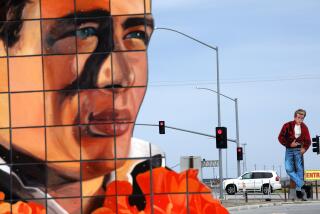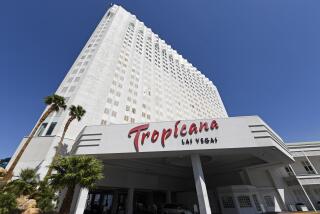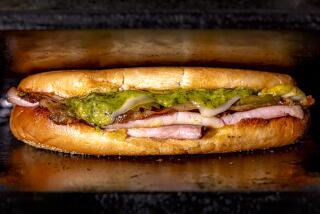Kirk Kerkorian dies at 98; shook up the car, movie and casino industries

Billionaire investor Kirk Kerkorian, who for a time was the richest person in Los Angeles, has died at 98.
No hotel in Las Vegas is named for Kirk Kerkorian. He’s not known for any ground-breaking innovation in the automobile industry, and he regularly turned down invitations to high-profile Hollywood events — even the Academy Awards.
But Kerkorian, an eighth-grade dropout who for a time was the richest person in Los Angeles, shook up the casino, auto and movie industries in turn, making a fortune not by focusing on a single endeavor, but by buying, selling and buying again.
He bought MGM Studios three times, always to his benefit if not the studio’s. He accumulated a sizable chunk of Chrysler Corp when it was vulnerable in the 1980s and did the same with General Motors in 2005.
And Kerkorian instinctively sensed the promise of Las Vegas on his first visits immediately after World War II. He built what was billed as the world’s largest hotel not once but three times, and acquired many of the city’s most famous properties, including the Bellagio and the Mirage.
“I’ve had more people tell me, did you envision this or that?” Kerkorian told The Times in a rare interview in 2005. “I just lucked into things. I used to think that if I made $50,000 I’d be the happiest guy in the world.”
Kerkorian, 98, who amassed a personal fortune estimated at $18 billion at one point, died Monday at his Beverly Hills home. Anthony Mandekic, chief executive of Kerkorian’s company, Tracinda Corp., said the death was due to age-related causes.
Kerkorian was not a recluse — he attended events he particularly enjoyed, including professional tennis matches — but he didn’t seek the limelight. He had no personal publicist, didn’t leak his strategy to the media and worked out of what was characterized as a charmless Beverly Hills office. He didn’t use a chauffeur and famously drove unflashy cars — a Pontiac Firebird, a Jeep Grand Cherokee.
When he wasn’t making deals, his great joys were playing tennis with friends and in seniors competitions, and watching movies, not at screenings but at local theaters in Century City and Westwood.
On the other hand, he enjoyed some trappings of wealth, including a 190-foot yacht and 737 jet, and he bought a second estate in the flats of Beverly Hills for those nights when the trip to his 30-acre Benedict Canyon compound was just too much.
“I’ve always felt he’s the most complicated man,” financier George Mason, one of Kerkorian’s best friends, said in 2005. “Yet he’s also the most simple man. He thinks differently than most of us. He finds the gut issue and focuses on that.”
In a 1969 interview with Fortune magazine, Kerkorian explained his strategy: “I don’t try to get all the meat off the bone. When I get a good figure, I just move something. Too many people try to hit the peak price and they hold on until it is too late.”
He did not, however, escape the recession meltdown. Though his $18-billion net worth in 2007 put him at No. 7 on the Forbes 400 list of richest Americans, in 2009 he fell to 97th on the list with a net worth of $3 billion.
Forbes most recently estimated his worth at $4 billion.
Kerkorian was not known as a meddlesome boss. He said he tried to hire good people and let them do whatever they thought necessary. Sometimes this worked out, most spectacularly — at least for a while — with his Las Vegas holdings, which grew through acquisitions to encompass about half the Strip’s hotel rooms.
His first big deal, in 1962, involved 84 acres of land that became the home of Caesar’s Palace. He built the International hotel (now the Westgate Las Vegas) that opened in 1969 and was billed as the largest resort hotel in the world. The first MGM Grand, which he built four years later, was 20% bigger.
Twenty years after that he built the MGM Grand Hotel and Theme Park.
“He literally built the world’s largest resorts three different times,” said Bo J. Bernhard, executive director of the International Gaming Institute at the University of Nevada at Las Vegas, on Tuesday. “The foundation of the enormous adult Disneyland is very much a Kerkorian invention.”
If the hotels Kerkorian built were famous for their size, they didn’t set hearts aflutter. He was a businessman, not a visionary. Steve Wynn was the artist in town. But when Wynn ran into trouble with his properties, including the Mirage and Bellagio, Kerkorian scooped them up.
At one point the company he founded as MGM Grand Inc. had 11 Las Vegas properties, also including the Luxor, Excalibur and New York New York.
But the recession hit Las Vegas particularly hard, and his stake in the properties was in large part responsible for the plunge in his personal fortune.
He helped plan the development of the multi-structure, multi-purpose CityCenter that opened in 2009 amid financial and legal disputes. Kerkorian left the board of the company, then called MGM Resorts International, in 2011.
In Hollywood, though he bought and sold the MGM studio multiple times, he was an outsider and not always beloved. His ownership of the studio was most notable for selling prized assets, including the historic studio lot in Culver City.
He also realized the worth of MGM’s vast library — he aggressively sold film rights to cable channels desperate for content in the 1980s.
He took over the studio the final time in 1996, not long before the DVD market took off.
“He uniquely knew the value of the MGM library and the need to protect it,” said Janet Janjigian, executive managing director of the Carmen Group West and a former MGM executive.
In 2004, he sold the studio to an investment group headed by Sony Corp., ending its fabled 80-year existence as an independent entity. Many in Hollywood held Kerkorian responsible for the studio’s demise.
Peter Bart, who worked at MGM in the 1980s, described Kerkorian in his 1990 book “Fade Out” as “a savvy Las Vegas game player” who harnessed “Hollywood’s mythmaking machinery to serve his personal objectives. The end result: Kerkorian emerged a billionaire. His companies emerged in shambles.”
In 2012, an executive of Tracinda — Kerkorian’s company named for his daughters Tracy and Linda — told the Wall Street Journal that Kerkorian was looking to get back into show business by buying a film studio or other entertainment company, but no such deal materialized.
Kerkorian’s record was checkered in the auto world, too. He believed the industry, particularly the domestic manufacturers, could become far more competitive and profitable, said Alan Baum, a West Bloomfield, Mich., auto industry consultant.
As an investor in Chrysler and General Motors, Kerkorian “pushed for better designed products and more reliable cars,” Baum said.
He was the largest shareholder in Chrysler before it was sold to Daimler-Benz in the late 1990s. In 2006, he bought a 9.9% stake in General Motors Corp. and tried to use the resulting leverage in an unsuccessful effort to force GM into a relationship with Nissan-Renault.
Kerkorian sought to mount a buyout of Chrysler with the help of the automaker’s unions, but failed.
He exited the auto industry in late 2008, as it was heading into its worst slump since the Great Depression. His deal that year to liquidate a stake in Ford was probably a money loser.
Only one book was ever written about Kerkorian: Los Angeles Times staff writer Dial Torgerson’s 1974 volume, “Kerkorian: An American Success Story.” Torgerson got much behind-the-scenes help from his subject, who on the record refused to be interviewed for it.
In many ways, it was the classic American immigrant story. Kerkorian rose from hard-scrabble poverty to comfort to extreme wealth, powered by little more than energy and guts.
Kerkor Kerkorian, later Americanized to “Kirk,” was born in Fresno on June 6, 1917. He was the fourth and last child of Lily and Ahron, both immigrants from Armenia, then part of the Ottoman empire.
Kerkorian’s first venture into real estate occurred at age 4. His father, who owned 10 heavily mortgaged farms in the Central Valley, put the family ranch into young Kirk’s name in a bold attempt to shelter the land from creditors. When the farms failed in the 1921-22 recession, the family moved to Los Angeles.
They moved often, from Lincoln Park to South Los Angeles to Jefferson Boulevard. “Everyone was hungry,” Kerkorian’s elder sister Rose, who died in 2012, said in a 2005 Times interview. “We had to move every three months because we couldn’t pay our rent.”
The poverty perhaps gave him a lifelong distrust of possessions. “I’m not married to anything,” Torgerson quoted him as saying frequently.
His formal education ended in the eighth grade at a school for delinquents at 6th and Main streets in downtown Los Angeles. Despite all his achievements and wealth, his early exit from school bothered him. He wished, he said in the 2005 Times interview, he had the silver tongue of fellow real estate developers Donald Trump or Wynn.
“I’ve always been a quiet guy,” Kerkorian said.
But he was a fighter, even with his fists. As an amateur boxer in his youth, he scored 29 wins, many by knockout, but “the Bakersfield Bomber,” also known as “Rifle Right Kerkorian,” wasn’t quite big or fast enough to make it as a pro. Instead, fate intervened. A friend working on his pilot’s license took Kerkorian on a ride in a Piper Cub from Alhambra Airport.
That lark turned into an obsession that would define his life for decades. Kerkorian got his own license, became a flight instructor and in 1942 took a job as a ferry pilot with the Royal Air Force. “I loved getting $1,000 a month — and the excitement,” he told the Times.
The thrills were considerable, according to Torgerson’s biography. The planes Kerkorian was transporting from Canada to Britain were De Havilland Mosquitoes — excellent fighters but poorly suited for a long flight across the icy ocean.
“Life is a big craps game,” Kerkorian said in 2005. He laughed. “I’ve got to tell you, it’s all been fun.”
Decades before his death, money ceased to have much personal importance. “I have made enough to retire, but that would be a pretty dull life for me, wouldn’t it?” he told The Times in 1969, when he was 52 and worth about $250 million.
Instead, friends agreed, he did deals to do them, to stay in the game, to beat the odds.
For all his attempts to stay under the radar, Kerkorian’s messy divorce from his third wife, former tennis pro Lisa Bonder, became a public spectacle in 2002 when she requested an increase in child support from $50,000 a month to $320,000 a month. And there was the added wrinkle of a paternity dispute — DNA tests showed Kerkorian was not the biological father of the child, born before they were married.
More typical of his life was the quiet manner in which he engaged in philanthropy. His Lincy Foundation — also named for his daughters — was founded in 1989, initially to aid victims of a devastating earthquake in Armenia. Over the years it gave more than $1 billion to various causes, including about $270 million to UCLA.
“He was one of the most generous people I’ve ever met, and one of the quietest about it,” Lee Iacocca, former Chrysler chief executive, said in a statement.
Unlike other major contributors, he did not request his name be put on buildings. And his gifts were not always to public institutions.
“He was the type of person who would have a $10 meal and give the waiter a $100 tip,” Jay Rakow, former MGM executive and head of the foundation, said Tuesday. “He never forgot where he came from.”
Kerkorian, who was married four times — most recently to Una Davis, according to a 2014 report in the Las Vegas Sun — was single at the time of his death. He is survived by daughters Tracy Kerkorian and Linda Kemper; and three grandchildren.david.colker@latimes.com
Times staff writers Ryan Faughnder, Jerry Hirsch, Meg James, Thomas Suh Lauder and Hugo Martin contributed to this report. Streitfeld is a former Times staff writer.







